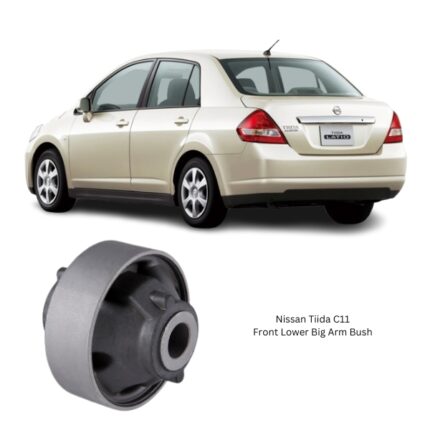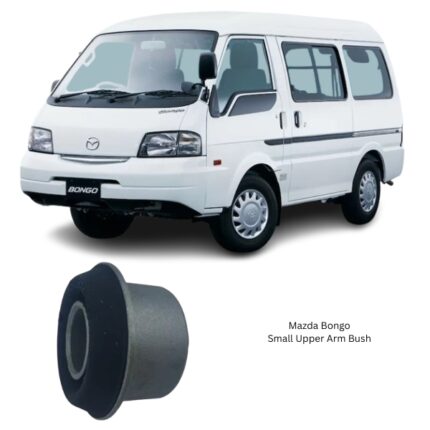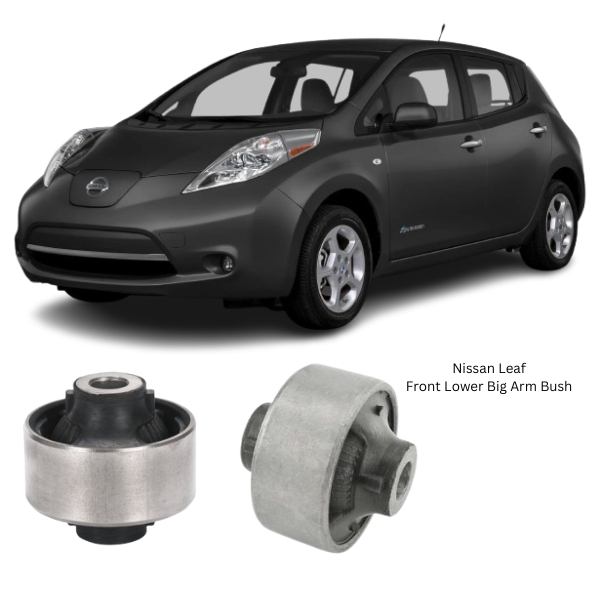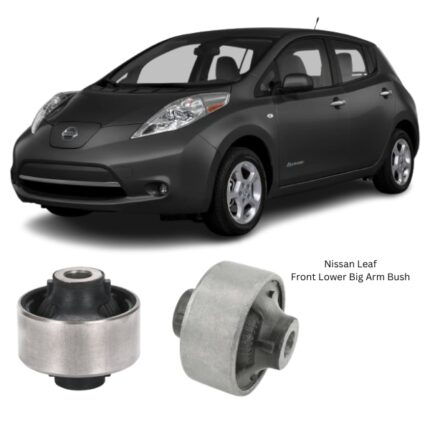Get Nissan Leaf Front Lower Big Arm Bush 54570-EN002 in Kenya
The Front Lower Big Arm Bush is a vital suspension component engineered to provide both flexibility and stability in the vehicle’s front suspension system. Positioned within the lower control arm—commonly known as the “big arm” due to its size and load-bearing capacity—this bushing acts as a pivot that allows the control arm to move vertically in response to changing road conditions while maintaining a solid connection to the vehicle chassis.
Though small and often overlooked, this component plays a key role in the suspension’s ability to absorb shocks, maintain alignment, reduce vibration, and preserve ride comfort. A worn or damaged front lower big arm bush can drastically compromise vehicle stability, handling performance, and overall driving safety.
Purpose and Role in the Suspension System
The suspension system in any vehicle is designed to maximize tire contact with the road while absorbing bumps, reducing vibration, and maintaining consistent steering geometry. The Front Lower Big Arm Bush serves as the critical connection point between the lower control arm and the vehicle’s subframe or chassis. It allows the arm to move in a controlled fashion without causing metal-to-metal contact or introducing excessive play.
Key Functions:
-
Controlled Flexibility: It permits the lower arm to move during suspension travel while limiting lateral or twisting motion that could disrupt wheel alignment.
-
Shock Absorption: Helps to absorb and dampen road vibrations and impacts, preventing harsh feedback from reaching the driver and passengers.
-
Alignment Retention: Maintains consistent wheel alignment (camber and toe angles), which is crucial for steering response and tire longevity.
-
Load Distribution: Efficiently distributes forces acting on the suspension, protecting the control arm, frame, and surrounding parts from stress concentration.
-
Vibration Isolation: Reduces the transmission of road-induced noise and vibration into the cabin, enhancing driving comfort.
Construction and Material Composition
The Front Lower Big Arm Bush is designed with precision to balance durability and elasticity. It typically consists of the following components:
-
Outer Metal Sleeve: Usually made of corrosion-resistant steel or aluminum, the outer casing fits securely into the control arm bracket.
-
Inner Metal Sleeve: Located at the core, this sleeve accommodates the mounting bolt and remains relatively stationary during operation.
-
Elastomeric Core: The core, typically made from natural rubber or high-grade polyurethane, allows for the controlled flexibility necessary for proper suspension operation.
-
Bonded Layers: The rubber or elastomer is chemically or mechanically bonded to both the inner and outer sleeves to ensure strength and consistent performance.
Material Variants:
-
Rubber Bushes: These are commonly used for standard driving applications. They provide excellent vibration dampening and comfort but may wear faster under high loads.
-
Polyurethane Bushes: Designed for performance or heavy-duty applications, these are more durable and offer greater resistance to deformation, though they may transmit more road feel into the cabin.
Bushings may also feature specially designed voids or directional grooves to enhance flexibility in certain planes while maintaining stiffness in others, depending on the vehicle’s suspension design requirements.
Performance Characteristics
A well-functioning Front Lower Big Arm Bush is essential for optimal vehicle dynamics. It must endure continuous movement, heavy loading, and harsh environmental conditions without failure.
Notable Performance Benefits:
-
Durability: Capable of withstanding years of cyclic loading without cracking, splitting, or tearing.
-
Resilience: Resistant to wear caused by exposure to oil, water, salt, and extreme temperatures.
-
NVH Control: Contributes to minimizing Noise, Vibration, and Harshness (NVH), delivering a smoother and quieter ride.
-
Handling Precision: Preserves suspension geometry, ensuring the vehicle handles predictably during acceleration, braking, and cornering.
-
Tire Protection: Maintains proper wheel alignment, preventing uneven or premature tire wear.
Symptoms of Wear or Failure
Over time, the Front Lower Big Arm Bush may wear out due to age, mechanical fatigue, or exposure to harsh environmental conditions. Recognizing early signs of failure can prevent more serious suspension issues.
Common Signs of a Failing Bush:
-
Clunking or Knocking Noises: Especially during braking, cornering, or driving over bumps, caused by metal parts moving without the buffer of a healthy bushing.
-
Poor Handling or Instability: The vehicle may feel loose or vague in its steering, particularly at higher speeds or under load.
-
Steering Pull: A worn bush may cause uneven suspension movement, leading to the vehicle pulling to one side.
-
Excessive Vibration: Increased road feedback through the steering wheel or chassis may be evident.
-
Uneven Tire Wear: Misalignment due to bush failure can cause tires to wear on the inner or outer edges prematurely.
-
Visual Damage: Cracks, splits, or rubber detachment visible upon inspection.
Prompt replacement is essential once any of these symptoms are observed to maintain vehicle safety and performance.
Installation and Replacement Process
Replacing the Front Lower Big Arm Bush is a job that typically requires removing the control arm from the vehicle and using a hydraulic press or specialty tool to remove and install the bushing.
General Replacement Steps:
-
Raise and Secure the Vehicle: Use a lift or jack stands to safely support the front end.
-
Remove the Control Arm: Unbolt the lower control arm from both the chassis and the steering knuckle.
-
Press Out the Old Bush: Carefully press out the worn bushing using a hydraulic press or extraction tool.
-
Install the New Bush: Press in the replacement bushing, ensuring correct alignment within the arm.
-
Reinstall the Control Arm: Reattach it to the vehicle and torque all bolts to manufacturer specifications.
-
Perform Wheel Alignment: Always align the wheels after suspension work to restore proper geometry.
Maintenance and Inspection Tips
Though bushings are not typically serviced until they show signs of failure, regular inspection can help detect issues early:
-
Check for cracking, sagging, or rubber separation during routine maintenance.
-
Pay attention to unusual sounds or vibrations during driving.
-
Inspect after impacts (e.g., hitting a pothole or curb) which may accelerate wear.
Benefits of Timely Replacement
-
Improved Steering Response
-
Reduced Cabin Vibration and Noise
-
Better Tire Life and Fuel Efficiency
-
Enhanced Ride Comfort
-
Greater Suspension Durability
Replacing worn front lower big arm bushes restores the full function of your vehicle’s suspension, enhancing comfort, safety, and performance.
Follow us on Facebook for more parts.





Reviews
Clear filtersThere are no reviews yet.